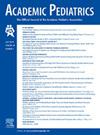儿童在就诊和COVID-19大流行期间接受氟化物清漆的变化
IF 2.8
3区 医学
Q1 PEDIATRICS
引用次数: 0
摘要
目的:建议初级保健医疗提供者在幼儿牙齿上涂氟化物清漆,以防止蛀牙。COVID-19大流行中断了卫生保健机构的护理服务,并可能对不同类型保险的患者产生不同影响。本研究的目的是检查2014-2022年期间儿童在医疗办公室接受氟化物清漆的变化。方法:使用来自马萨诸塞州(2014-2022年)的所有付款人索赔数据,我们检查了儿童在医疗访问期间的氟清漆收据,整体时间和保险类型。由于2019年的利率最高,因此将其作为参考年。我们检查了结果是否由接受(或不接受)医疗访问驱动。结果:随着2014年至2019年的增长,与2019年相比,拥有私人保险的儿童在2022年接受氟化物漆的概率降低了2.4(95%置信区间(CI)= -3.5至-1.3)个百分点(pp),而拥有医疗补助的儿童则降低了6.0 (95% CI= -8.0至-4.0)个百分点,分别下降了15%和37%。在此期间,我们没有观察到儿童就诊次数的类似下降,当我们控制就诊次数时,我们对氟化物清漆收据的发现是相似的。结论:在COVID-19大流行期间,幼儿的氟化物清漆使用量急剧下降,这不能用健康儿童就诊次数下降来解释。接受医疗补助的儿童的下降幅度更大,抹杀了近十年来在推广这种基于证据的预防服务方面取得的进展。本文章由计算机程序翻译,如有差异,请以英文原文为准。
Changes in Children’s Receipt of Fluoride Varnish During Medical Visits and the COVID-19 Pandemic
Objective
Primary care medical providers are recommended to apply fluoride varnish to the teeth of young children to prevent tooth decay. The COVID-19 pandemic interrupted care delivery in health care settings and may have differentially impacted patients with different types of insurance. The objective of this study was to examine changes in children’s receipt of fluoride varnish in the medical office during 2014–2022.
Methods
Using all-payer claims data from Massachusetts (2014–2022), we examined children’s receipt of fluoride varnish during medical visits over time overall and by insurance-type. Because rates were highest in 2019, this was used as the reference year. We examined if results were driven by receipt (or non-receipt) of medical visits.
Results
Following growth from 2014 to 2019, the probability of a child receiving fluoride varnish in 2022 compared to 2019 was 2.4 (95% confidence interval [CI] = −3.5 to −1.3) percentage points (pp) lower for a child with private insurance and 6.0 (95% CI = −8.0 to −4.0) pp lower for a child with Medicaid, representing declines of 15% and 37%, respectively. We did not observe a similar decline in children’s receipt of medical visits during this time and our findings on fluoride varnish receipt were similar when we controlled for receipt of medical visits.
Conclusions
Fluoride varnish receipt among young children declined precipitously during the COVID-19 pandemic and was not explained by declines in well-child medical visits. Declines were greater for children with Medicaid, erasing nearly a decade of progress in promotion of this evidence-based preventive service.
求助全文
通过发布文献求助,成功后即可免费获取论文全文。
去求助
来源期刊

Academic Pediatrics
PEDIATRICS-
CiteScore
4.60
自引率
12.90%
发文量
300
审稿时长
60 days
期刊介绍:
Academic Pediatrics, the official journal of the Academic Pediatric Association, is a peer-reviewed publication whose purpose is to strengthen the research and educational base of academic general pediatrics. The journal provides leadership in pediatric education, research, patient care and advocacy. Content areas include pediatric education, emergency medicine, injury, abuse, behavioral pediatrics, holistic medicine, child health services and health policy,and the environment. The journal provides an active forum for the presentation of pediatric educational research in diverse settings, involving medical students, residents, fellows, and practicing professionals. The journal also emphasizes important research relating to the quality of child health care, health care policy, and the organization of child health services. It also includes systematic reviews of primary care interventions and important methodologic papers to aid research in child health and education.
 求助内容:
求助内容: 应助结果提醒方式:
应助结果提醒方式:


